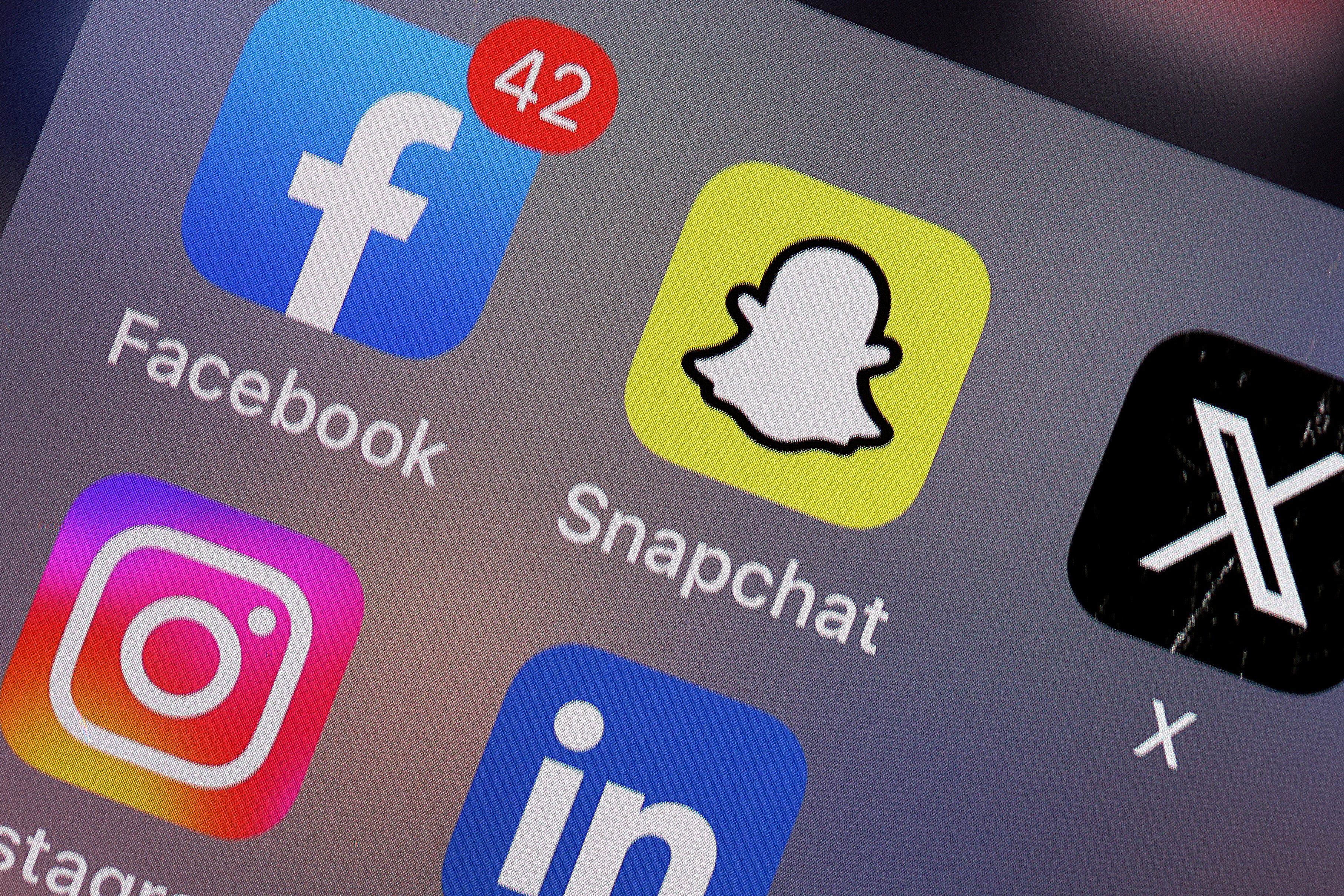After Adolescence: The new Snapchat feature that is sending anxiety rates soaring among British teenagers
As parents are only just realising what the red pill means on social media, generational expert Chloe Combi uncovers another evil genius marketing tool Snapchat has introduced that keeps teenagers addicted – and panicking

One of my biggest criticisms of Adolescence, the monster hit and now cultural and political bellwether, is the way that, in the show, 13-year-old Jamie Miller is being bullied by his classmates online. I don’t take issue with the bullying part – social media is a crucible of tension and nastiness that often explodes into all kinds of real-life conflict, especially for teenagers. My issue is with the fact that the bullying takes place on Instagram.
Very few 13-year-olds use Instagram much any more, and Gen A (Generation Alpha – those born since about 2010) even consider TikTok to be a bit naff and symbolic of Gen Z (the previous generation, and one they see as being culturally over the hill). Gen A are all about Snapchat, with 84 per cent of them using it daily in the UK: it is their biggest communication platform with each other.
Snapchat is often viewed by parents as more benign, because it’s not inherently a broadcast-style social media platform like Instagram or TikTok; many see it as a kind of WhatsApp with more emojis. Carol, who has two teen daughters, is typical of many when she says: “I don’t let either of my girls use TikTok, and they only watch YouTube – they don’t post. Snapchat is fine because it just allows them to chat to their friends privately in groups.”
The cartoon-like format gives it an innocent glow, but the impression some have of Snapchat – that, when controlled, it is like a private chat group – is misleading. Snapchat groups can be sprawling, and it’s often difficult to know for sure who’s in the chat. The wildly popular Bitmoji feature means you don’t really know who you are talking to, as your identity is hidden behind a customised cartoon feature. All kinds of bullying and toxicity happen behind those cute customised cartoons – and a lot of bullying happens on Snapchat.
The tragic suicide of 14-year-old Mia Janin, who attended the Jewish Free School in north London, was linked to the hideous bullying she experienced from her classmates on Snapchat.
Crucially, the messages on Snapchat are also ephemeral: they are deleted once viewed. Group chats are deleted after seven days. So, if there is something damning on there, the sender can simply deny it and there’s no remaining evidence unless you’ve screenshotted it.
But if you are subjected to a torrent of abuse, which happens frequently to teens, it can be hard, not to mention distressing, to screenshot everything. Snapchat streaks – a function that encourages users to send each other at least one picture every 24 hours – is addictive, and causes a huge amount of stress. Snapchat also reveals your location if you post a picture and haven’t explicitly turned the function off.
However, an interesting, and somewhat worrying, evolution of the app is how it has replaced “soft dating” and real-life flirting. Prior to phones and social media, if you had a crush, you might have hung out at the park in a group and maybe progressed to going to the cinema if things got a bit more serious. But many young people use Snapchat as their hangout, and naturally this comes with politics and coded behaviours of the sort that are the everyday lived experience of teens, but are hardly known among their parents.
One of the big horrors of modern life for a teenager – particularly if you have sent something that is meaningful, or makes you vulnerable – is to be “left on read” – this means that your post has been read but left unanswered (the unfilled blue arrow).
For most adults, a “read but not responded” is met with a “Meh, they’re probably busy/will reply later.” But for teens, this single hollow blue arrow icon can precipitate a spiral of anxiety in which all kinds of awful conclusions are drawn.

Jenna, 14: “If friends leave me on read and don’t reply, I immediately panic that they don’t like me or are all talking about me. I have to send another Snap straight away that might interest them more, so that they reply.”
Kat, 15: “I’d die if I sent a boy I liked a Snap and he left it on read. Like, die. My friend did it to a boy who was popular in the year above, and he left it on read and she spiralled. We had to sit up all night with her and talk her down.”
The spiral wasn’t called for – it turned out he was just revising and didn’t have time to reply straight away, so it all worked out in the end, but, says Kat, “That was a bad night. None of us slept.”
Of course, adults reading this will throw their hands up and say “Lesson learnt, time to get a life.” We can all sympathise with the plight of “revising boy”, but young people’s capacity for anxiety over the smallest perceived slights is a boon for these platforms. They are tuned into their turmoil, and know how to feed off it – and cash in on it, too.
Snapchat had a seemingly clever solution for this: the half-swipe. The half-swipe is when you can literally half-swipe the message, briefly viewing its contents without fully opening it, meaning it’s not left on read and there isn’t the pressure to respond. But the problem is, teens all know about the half-swipe – yet another spiral waiting to happen.

So, Snapchat has come up with another evil genius solution to the half-swipe panic – one that not only can be monetised, but will make the product even more addictive. If you subscribe to Snapchat+ (£3.99 a month) it comes with the “peek a peek” feature, which means you can catch someone in the act of half-swiping, as the eyeball emoji pops up when they do it. But here’s the problem (or one of many): you have to catch them in the act – and in order to do so, teens have to be looking at their phones all the time.
Fifteen-year-old Ivan illustrates the problem neatly: “My mate asked this really popular girl out on Snap, and then got obsessed with the idea she might half-swipe him. My dad took us to the football, and the tickets were really expensive, and we spent the entire match staring at my mate’s phone, trying to catch her in the half-swipe!”
Ebony, also 15, has had a similar experience: “Half-swipe is horrible. We have half-swipe sessions, where we take shifts to watch someone’s phone if they have sent a Snap they’re worried about. It’s bad for anxiety.”
This all might sound ludicrous to adults; the closest Gen-Xers and boomers came to this kind of anxiety is the hours spent next to a landline waiting for that call from a special someone. But the worrying development for teens today is how Big Tech can manipulate anxieties around teen friendship and romance to make their tech more addictive – not to mention make money from it.
_n_S1_E3_00_25_31_20.jpeg)
Teenagers are missing out on real-life experiences because they now have yet another incentive to stare at a screen every waking hour. The half-swipe tracker has become one more reason to take their phones to bed, and to school, and to consume whatever content on there is being served up.
Meaner teens can make hay from someone’s vulnerability – or worse – with groups, or anyone in their contacts. It adds to social media’s complexity, too. Emojis mean different things on different platforms: there are a variety of subtle codes, signifiers and behaviours that underscore how online communications can become a social minefield.
And if you were in any doubt about how lucrative all this teenage anxiety is, since the half-swipe tracker function was brought in, the Snapchat+ subscription has grown its revenue by more than 131 per cent, bringing in at least $500m (£380m). That’s a lot of eyeballs. And internal panic. 👀
You can read more of Chloe Combi’s work here
If you are experiencing feelings of distress, or are struggling to cope, you can speak to the Samaritans, in confidence, on 116 123 (UK and ROI), email jo@samaritans.org, or visit the Samaritans website to find details of your nearest branch.
If you are based in the USA, and you or someone you know needs mental health assistance right now, call or text 988, or visit 988lifeline.org to access online chat from the 988 Suicide and Crisis Lifeline. This is a free, confidential crisis hotline that is available to everyone 24 hours a day, seven days a week. If you are in another country, you can go to www.befrienders.org to find a helpline near you



Join our commenting forum
Join thought-provoking conversations, follow other Independent readers and see their replies
Comments